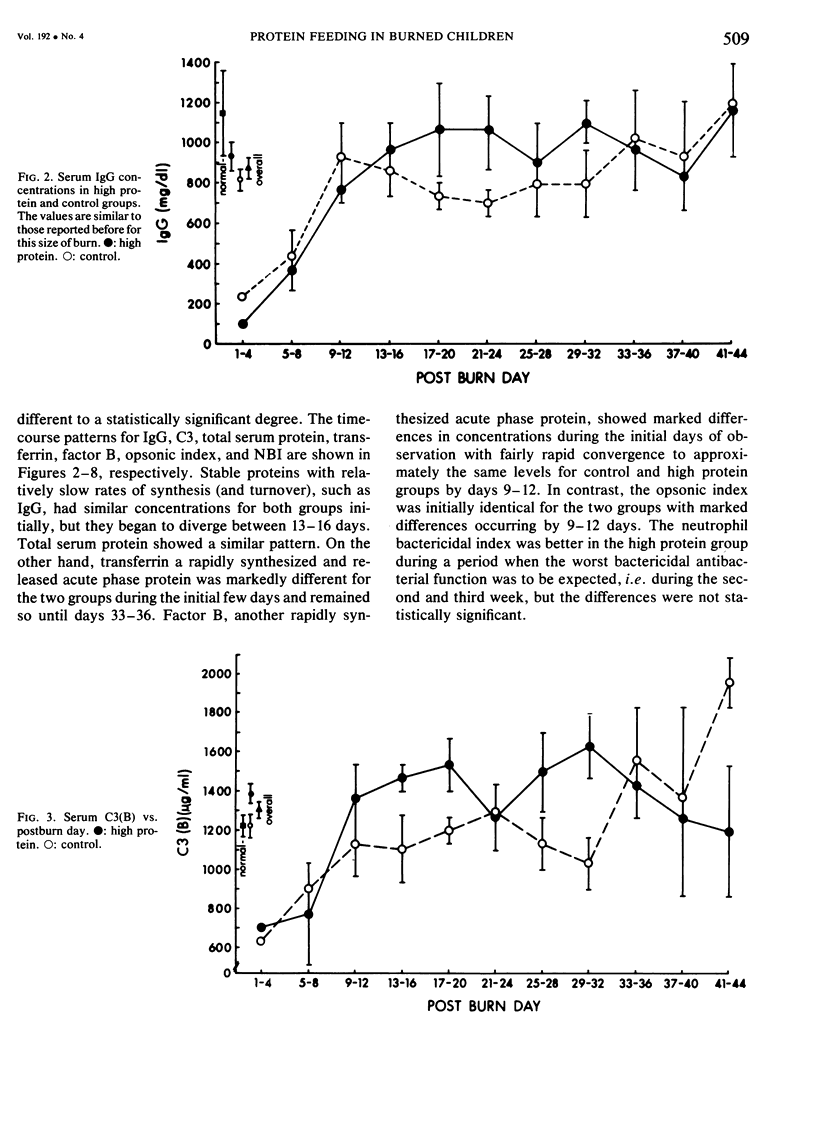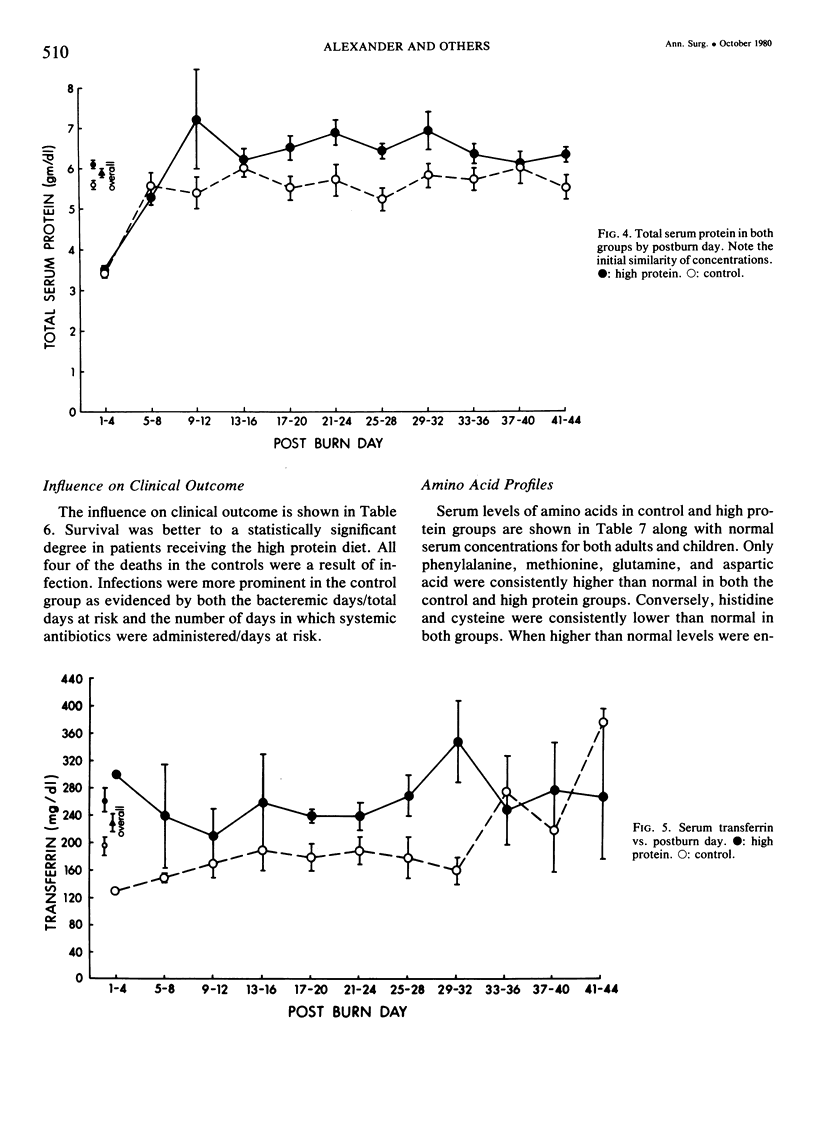Abstract
To determine any potential benefit of feeding increased amounts of protein to hypermetbolic burned patients, 18 children with burns averaging 60% total surface area were randomized into two matched groups and studied serially for at least six weeks: the first group was given a normal diet with a balanced nutritional supplement, and the second group was supplemented with milk whey protein. The normal protein group received 87.1% of their desired caloric intake with 16.5% of calories from protein compared to 77.7% of desired caloric intake with 23.0% of calories from protein for the high protein group. Despite a higher caloric intake, the normal protein group had a worse opsonic index compared to the high protein group (0.42 +/- 0.04 vs. 0.62 +/- 0.05, p < 0.0007), lower levels of C3 (1371 +/- 55 vs. 1585 +/- 64 micrograms/ml, p < 0.01), lower levels of IgG (805 +/- 52 vs. 975 +/- 56 micrograms/ml, p < 0.03), lower levels of transferrin (200 +/- 10 vs. 283 +/- 18 mg/dl, p < 0.0001), lower levels of total serum protein (5.5 +/- 0.1 vs. 6.3 +/- 0.2 g/dl, p < 0.005), more bacteremic days (11% vs. 8%, p < 0.005) and worse survival (5/9--56% vs. 9/9--100%, p < 0.03). Patients receiving the high protein diet had significantly higher plasma levels of valine, lysine, threonine, leucine, aginine, isoleucine, proline, serine, asparagine, tryptophane, and tyrosine. Asparagine levels were significantly (p < 0.01) associated with better neutrophil function and opsonic index. Except for phenylalanine, significant associations were found for serum levels of each of the amino acids with concentrations of one or more serum proteins. These studies provide evidence that many immunologic functions are dependent upon optimal availability of specific amino acids, and that routine diets do not provide sufficient protein to satisfy the needs of seriously burned children.
Full text
PDF











Selected References
These references are in PubMed. This may not be the complete list of references from this article.
- Abel R. M., Beck C. H., Jr, Abbott W. M., Ryan J. A., Jr, Barnett G. O., Fischer J. E. Improved survival from acute renal failure after treatment with intravenous essential L-amino acids and glucose. Results of a prospective, double-blind study. N Engl J Med. 1973 Apr 5;288(14):695–699. doi: 10.1056/NEJM197304052881401. [DOI] [PubMed] [Google Scholar]
- Alexander J. W., Stinnett J. D., Ogle C. K., Ogle J. D., Morris M. J. A comparison of immunologic profiles and their influence on bacteremia in surgical patients with a high risk of infection. Surgery. 1979 Jul;86(1):94–104. [PubMed] [Google Scholar]
- Alexander J. W., Windhorst D. B., Good R. A. Improved tests for the evaluation of neutrophil function in human disease. J Lab Clin Med. 1968 Jul;72(1):136–148. [PubMed] [Google Scholar]
- HIRSCH J. G., STRAUSS B. STUDIES ON HEAT-LABILE OPSONIN IN RABBIT SERUM. J Immunol. 1964 Jan;92:145–154. [PubMed] [Google Scholar]
- Mancini G., Carbonara A. O., Heremans J. F. Immunochemical quantitation of antigens by single radial immunodiffusion. Immunochemistry. 1965 Sep;2(3):235–254. doi: 10.1016/0019-2791(65)90004-2. [DOI] [PubMed] [Google Scholar]
- REISS E., PEARSON E., ARTZ C. P. The metabolic response to burns. J Clin Invest. 1956 Jan;35(1):62–77. doi: 10.1172/JCI103253. [DOI] [PMC free article] [PubMed] [Google Scholar]
- Scrimshaw N. S. Effect of infection on nutrient requirements. Am J Clin Nutr. 1977 Sep;30(9):1536–1544. doi: 10.1093/ajcn/30.9.1536. [DOI] [PubMed] [Google Scholar]
- Wilmore D. W., Curreri P. W., Spitzer K. W., Spitzer M. E., Pruitt B. A., Jr Supranormal dietary intake in thermally injured hypermetabolic patients. Surg Gynecol Obstet. 1971 May;132(5):881–886. [PubMed] [Google Scholar]
- Young G. A., Collins J. P., Hill G. L. Plasma proteins in patients receiving intravenous amino acids or intravenous hyperalimentation after major surgery. Am J Clin Nutr. 1979 Jun;32(6):1192–1199. doi: 10.1093/ajcn/32.6.1192. [DOI] [PubMed] [Google Scholar]


